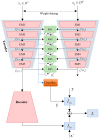Tackling Few-Shot Challenges in Automatic Modulation Recognition: A Multi-Level Comparative Relation Network Combining Class Reconstruction Strategy
- PMID: 39001199
- PMCID: PMC11244464
- DOI: 10.3390/s24134421
Tackling Few-Shot Challenges in Automatic Modulation Recognition: A Multi-Level Comparative Relation Network Combining Class Reconstruction Strategy
Abstract
Automatic Modulation Recognition (AMR) is a key technology in the field of cognitive communication, playing a core role in many applications, especially in wireless security issues. Currently, deep learning (DL)-based AMR technology has achieved many research results, greatly promoting the development of AMR technology. However, the few-shot dilemma faced by DL-based AMR methods greatly limits their application in practical scenarios. Therefore, this paper endeavored to address the challenge of AMR with limited data and proposed a novel meta-learning method, the Multi-Level Comparison Relation Network with Class Reconstruction (MCRN-CR). Firstly, the method designs a structure of a multi-level comparison relation network, which involves embedding functions to output their feature maps hierarchically, comprehensively calculating the relation scores between query samples and support samples to determine the modulation category. Secondly, the embedding function integrates a reconstruction module, leveraging an autoencoder for support sample reconstruction, wherein the encoder serves dual purposes as the embedding mechanism. The training regimen incorporates a meta-learning paradigm, harmoniously combining classification and reconstruction losses to refine the model's performance. The experimental results on the RadioML2018 dataset show that our designed method can greatly alleviate the small sample problem in AMR and is superior to existing methods.
Keywords: automatic modulation recognition; deep learning; few-shot learning; relation network.
Conflict of interest statement
The authors declare no conflict of interest.
Figures










References
-
- Wang Y., Gui G., Gacanin H., Ohtsuki T., Sari H., Adachi F. Transfer Learning for Semi-Supervised Automatic Modulation Classification in ZF-MIMO Systems. IEEE J. Emerg. Sel. Top. Circuits Syst. 2020;10:231–239. doi: 10.1109/JETCAS.2020.2992128. - DOI
-
- Meng F., Chen P., Wu L., Wang X. Automatic Modulation Classification: A Deep Learning Enabled Approach. IEEE Trans. Veh. Technol. 2018;67:10760–10772. doi: 10.1109/TVT.2018.2868698. - DOI
-
- Shi J., Hong S., Cai C., Wang Y., Huang H., Gui G. Deep Learning-Based Automatic Modulation Recognition Method in the Presence of Phase Offset. IEEE Access. 2020;8:42841–42847. doi: 10.1109/ACCESS.2020.2978094. - DOI
-
- Rajendran S., Meert W., Giustiniano D., Lenders V., Pollin S. Deep Learning Models for Wireless Signal Classification with Distributed Low-Cost Spectrum Sensors. IEEE Trans. Cogn. Commun. Netw. 2018;4:433–445. doi: 10.1109/TCCN.2018.2835460. - DOI
-
- O’Shea T.J., Corgan J., Clancy T.C. Convolutional radio modulation recognition networks; Proceedings of the Engineering Applications of Neural Networks: 17th International Conference, EANN 2016; Aberdeen, UK. 2–5 September 2016; pp. 213–226. Proceedings 17.
LinkOut - more resources
Full Text Sources
Other Literature Sources

